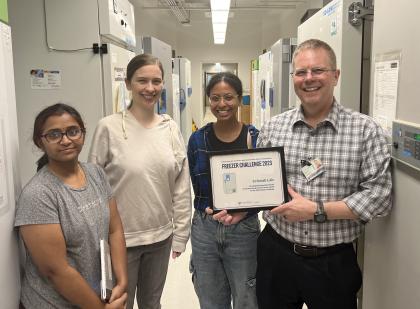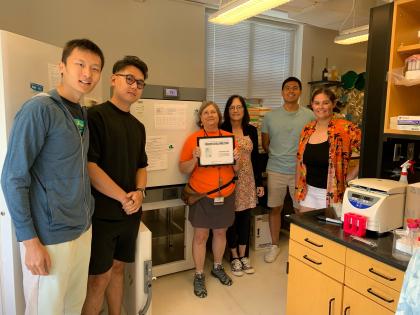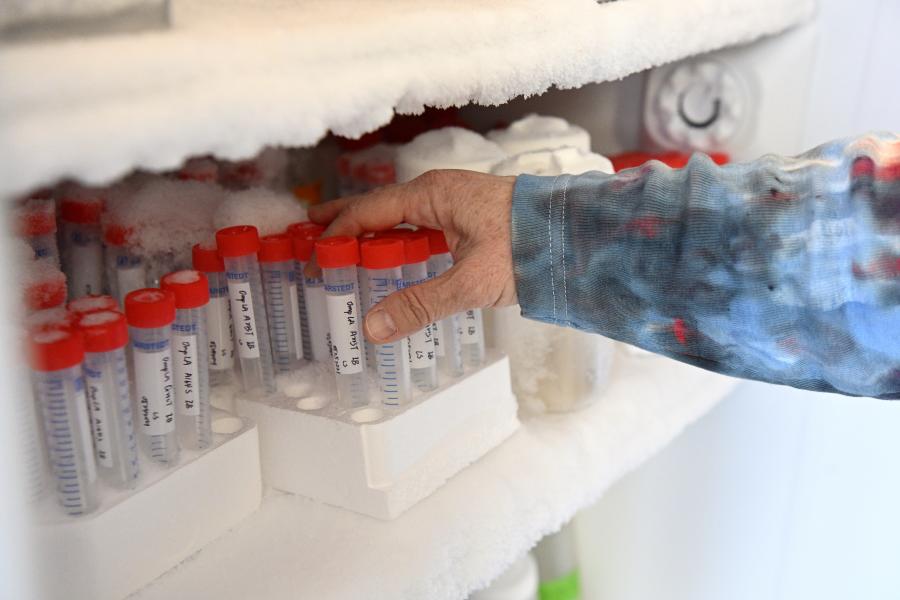More than 1,500 ultra-low temperature lab freezers are maintained across Baltimore by Johns Hopkins University. Just a single one of these units can drain as much energy as a single-family home, collectively using millions of kilowatt-hours (kWh)—and dollars—each year.
"A lot of us in research will crank them as cold as we can get them because we have this mindset that the colder, the better," explained lab manager James Leatherman. "Freezers are some of the biggest energy hogs that we have."
But in recent years, a competition to make freezer use more efficient has been heating up between JHU labs.

Image caption: Members of the Schwab Lab
Image credit: Johns Hopkins University
The International Laboratory Freezer Challenge is an annual competition organized by My Green Lab and the International Institute for Sustainable Laboratories. During the six months of the challenge, labs around the world strive to reduce their energy consumption by improving the efficiency of their cold storage units. Efforts can include temperature tuning, inventory management, and upgrading old technology.
With nearly 2,000 labs and more than 26,000 freezers participating globally in 2023, this year's challenge doubled last year's accomplishments by saving a collective 20.7 million kWh of energy—the equivalent of 14,663 metric tons of CO2 or 37.5 million miles driven by an average gas-powered vehicle.
At Hopkins, 34 entries representing 56 labs participated in the 2023 Freezer Challenge, collectively lowering the university's energy consumption by an estimated 1,202 kWh per day, the equivalent of the energy needed to power 39 single family homes. This marked a 250% increase in participation and an over 160% increase in energy savings for JHU compared to last year's challenge. For these efforts, Johns Hopkins University earned an honorable mention for being one of the competition's top-performing academic institutions. Several individual labs were further recognized, including the GI Oncology Lab, which won the award for Top Large Lab in the academic sector.

Image caption: Members of the Fleming Lab
Image credit: Johns Hopkins University
"I can't change everything," said Leatherman, who manages the GI Oncology Lab. "I can't change something like chemicals, I can't change all of my plastics, but I can change the way we look at and use electricity and maintain the equipment."
Johns Hopkins Facilities and Real Estate also offered a $5,000 prize to the top-performing lab in each school as part of competition organized by the JHU Green Labs Program. Winners were the School of Medicine's Quinn/Tobian Lab, the Bloomberg School of Public Health's Schwab Lab, and the Fleming Lab on the Homewood campus. These labs went above and beyond with their efforts to reduce energy consumption, in some cases discarding enough samples to retire entire freezers.
Hopkins labs interested in joining the 2024 Freezer Challenge can sign up on the Office of Sustainability's website. To get a head start, labs can begin implementing the following suggestions for their cold storage units:
Raise temperature settings: While many ultra-low freezers are set to around -80°C, recent studies have shown that temperatures as high as -70°C can be just as effective for safely preserving samples while using significantly less energy and increasing a freezer's lifespan.
Discard old samples: If a sample is old, unnecessary, or past its expiration date, consider getting rid of it. Reducing the number of samples can allow a lab to use fewer freezers, greatly reducing energy consumption and electricity bills.
Map out contents: The longer a freezer door is open, the more energy a unit requires to return to its set temperature. By reorganizing and mapping out the contents of a freezer, researchers can find the samples they're looking for more quickly, limiting the amount of time that freezer doors need to be open.
Clean regularly: Although many assume that frost and ice build-up makes freezers colder, the debris actually hinders airflow, forcing the unit to work harder and consume more energy. Removing this build-up, as well as any dust or grime in the unit's air filter, can make a freezer more efficient and increase the unit's lifespan.
Retire old freezers: While older ultra-low freezers use 20-30 kWh per day, newer models can get by on as little as five. Labs with old freezers should consider updating their machines. Contact the Office of Sustainability for a list of energy-efficient models.
"Every little bit that we can do helps," Leatherman said. "It may not benefit you directly as a single lab, but please think about the overall university's goal. … We should not just be stewards of our lab. We should be stewards of this building and stewards of the environment. Starting with freezers doesn't just provide a safer, more reliable environment for ourselves and our partners and our research, but also for Johns Hopkins and the community."
Posted in University News
Tagged sustainability








